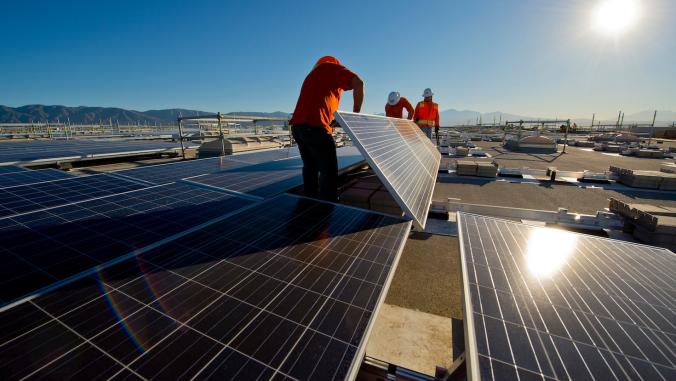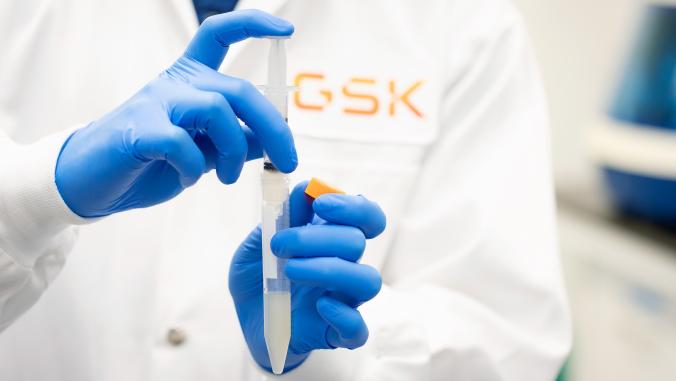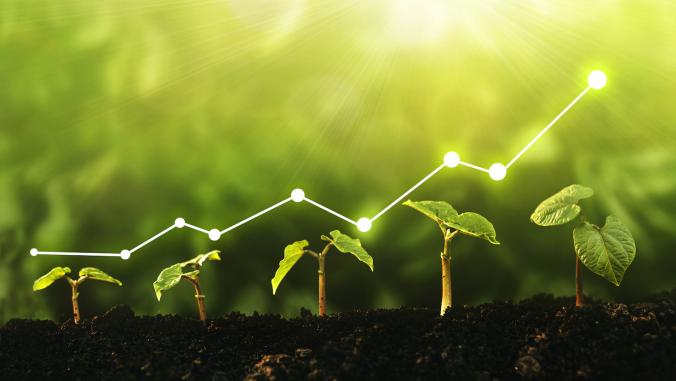Signs of progress for green chemistry
Three advances are bringing the concept into the mainstream: better communications, policy support and meaningful collaboration.

Speakers at the GreenBiz 20 breakout, from left: Michele Jalbert, GC3 (speaking); Avery Lindeman, Gap; Martin Wolf, Seventh Generation; and Viviana Alvarez, Unilever.
Green chemistry as a concept has been kicking around since the 1990s, when the Environmental Protection Agency’s Office of Pollution Prevention and Toxins first coined the phrase. Decades of research and the proliferation of green chemistry groups, journals and conferences have yet to bear much fruit, however, as more than 98 percent of chemicals today are still petroleum-based products with varying degrees of health and environmental impact.
But that may be changing, say representatives from Unilever, Gap, Seventh Generation and the nonprofit, business-to-business forum Green Chemistry & Commerce Council (GC3). During a GreenBiz 20 workshop, "Green Chemistry: Building a Vision for Innovation," in early February, panelists discussed advancements in three priority areas that could help bring green chemistry into the mainstream: informing the marketplace; securing supportive policies; and collaborating up and down the supply chain.
Informing the marketplace: Green chemistry is sustainable chemistry
Green chemistry’s 12 foundational principles for hazard-free chemical design are well accepted by the scientific community, but not so easy for non-scientists to understand. That’s been a barrier to progress.
To accelerate adoption of green chemistry, said Michele Jalbert, co-director of GC3, "you need to persuade people at the C-suite and in your supply chains. You need a language that can create a dialogue."
Simpler language that reframes the principles of green chemistry as "sustainable chemistry" can do that, she said. "Sustainable chemistry pings on all the right notes for the C-suite and decision-makers in your companies." The focus is on how sustainable chemistry can demonstrate improvements in health and the environment while achieving other broad sustainability goals such as increased energy efficiency and reducing waste and natural resource use.
Sustainable chemistry adds additional elements that support commercialization and adoption and circularity. "What works in the lab has to work in the products and the whole supply chain you have in place,” explained Jalbert. "These new elements are really important to help connect it to what business in leadership is dealing with now."Companies are under pressure to get chemicals out of their supply chains, or they want new, sustainable options. Market demand is huge.
Avery Lindeman, manager of sustainable chemistry at Gap Inc, agreed, saying that Gap uses the term sustainable chemistry internally rather than green chemistry. Gap doesn’t sell products with chemicals in them, so sustainable chemistry for the apparel company is "about safer materials in production,” she said. "It touches our other environmental goals, like water and energy savings, water stewardship."
Gap focuses on giving "actionable tools and guidance" to its internal business partners, designers and the facilities it sources product from so that "we can make better choices," Lindeman said.
For Martin Wolf, director, sustainability and authenticity at Seventh Generation, sustainable chemistry fits with the company’s approach to product design, which centers on "how to make something sustainable by starting with a renewable material, or a material that’s been renewed, and keeping it in a form that it can be renewed at end of the product’s use."
For Seventh Generation that means, for example, selecting bio-based materials that can biodegrade and using recycled plastic in packaging. Seventh Generation also does not use any classes of chemicals that are carcinogenic, mutagenic or known reproductive toxins.
Smart policies on the way
Messaging green chemistry as sustainable chemistry is particularly helping GC3 win legislative approval for supportive policies, Jalbert said.
GC3 is part of a broad alliance of industry associations, chemical manufacturers, consumer product companies and the nonprofit Environmental Working Group that is working to pass a bill that would coordinate federal research and development into sustainable chemistry.
That’s important because current federal research dollars are disjointed and spread across numerous agencies, from the Department of Defense to the U.S. Department of Agriculture to the Department of Energy (DOE), Jalbert said. The Sustainable Chemistry Research and Development Act (S. 999 and H.R. 2051), sets up a coordinating function for organizing and sharing information, and for creating a roadmap for public-private sector innovation to amplify and accelerate progress.
The bill passed the House of Representatives and made it out of the Senate Commerce Committee last year. Jalbert is optimistic that the Senate will pass the bill because it’s backed by groups such as the National Association of Manufacturers and the U.S. Chamber of Commerce.
"There’s huge market demand for sustainable chemistry across every sector. It’s an emerging area," she said, citing a 2018 Government Accountability Office report that lays out the enormous opportunity from an economic standpoint.We’re framing all our efforts as a business issue, about innovation, American competitiveness, advanced manufacturing.
"We’re framing all our efforts as a business issue, about innovation, American competitiveness, advanced manufacturing," Jalbert added. "We found that this framing in the current political environment is really, really effective."
GC3 and others are also working on getting additional funds through the appropriations process for a sustainable chemistry grant program out of the DOE’s Advanced Manufacturing Office.
Collaborations are getting stronger
"Alignment from all the brand customers makes it much easier for the supply chain to know what we’re asking and put resources to delivering on it," said Lindeman, citing Gap’s participation in the Zero Discharge of Hazardous Chemicals (ZDHC) collaboration. ZDHC started in 2011 in response to a Greenpeace campaign and includes 30 signatory brands, 101 value chain affiliates and 19 associates.
The collaboration brought together apparel and footwear companies to align on a restricted substances list to communicate to suppliers. "But there’s still more work to be done to identify best available, alternative chemicals," Lindeman said.
GC3, which brings supply chain members together to accelerate adoption of green chemistry, has seen tremendous growth over the past three years, according to Jalbert.
"Companies are under pressure to get chemicals out of their supply chains, or they want new, sustainable options. Market demand is huge," she said, explaining the growth. The collaboration counts more than 120 member companies, ranging from tiny startups to retail giants such as Amazon and Walmart.
GC3’s Retail Leadership Council, comprising 10 consumer giants such as Best Buy, CVS and Target, released a Statement on Chemical Innovation Priorities (PDF) in May naming specific chemical functions, such as plasticizers and solvents, as well as classes of hazardous chemicals. It "sends a very clear signal across the market, across supply chains, that this is where retailers see the need for chemical innovation,"Jalbert said. A year and a half in the making, the statement gives critical guidance to chemical manufacturers and startups to help them prioritize their efforts at innovation and R&D.
Another new business/NGO partnership called ChemForward is working to systematize the evaluation of alternatives to known hazardous chemicals. Funded by Google, Target and several foundations, the collaboration has similar, enormous potential for moving the needle.
"I think it’s the natural evolution of businesses, adapting to these new realities," said Viviana Alvarez, head of sustainability, North America Unilever. "We have the new technologies, we have the science, we don’t have the excuses of new ways of working."





